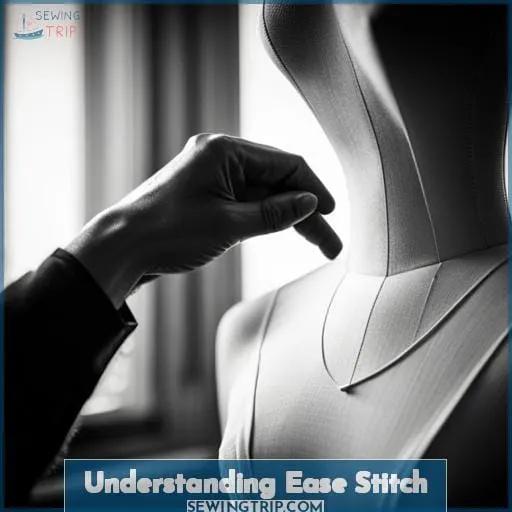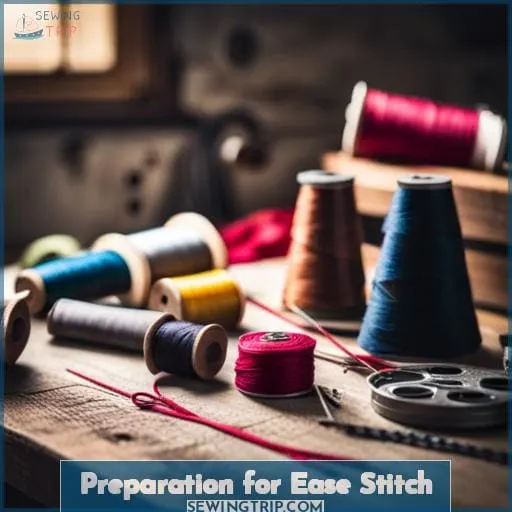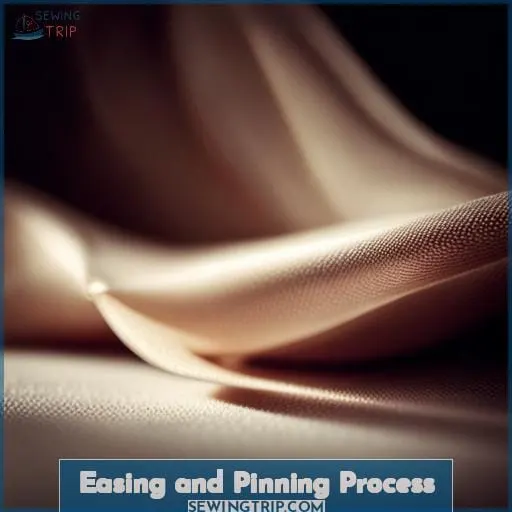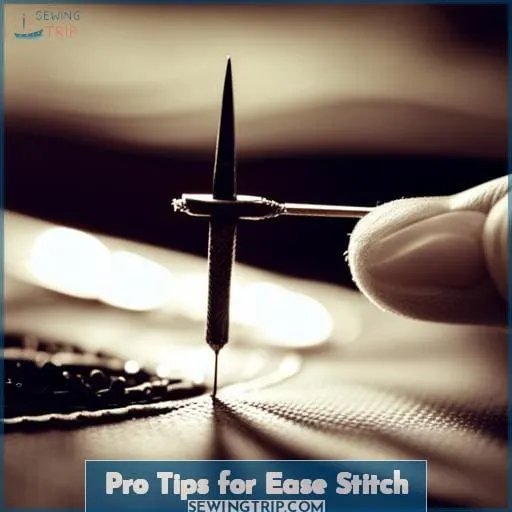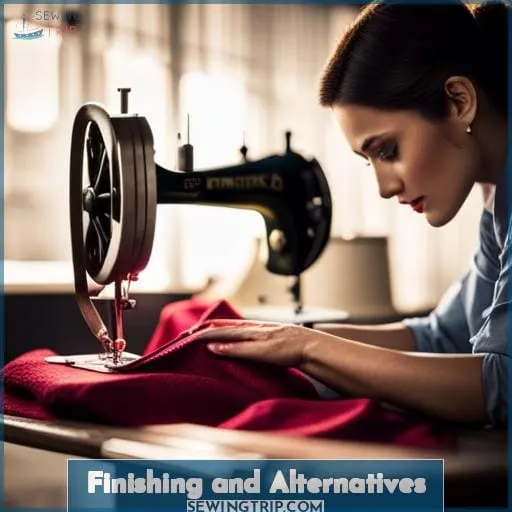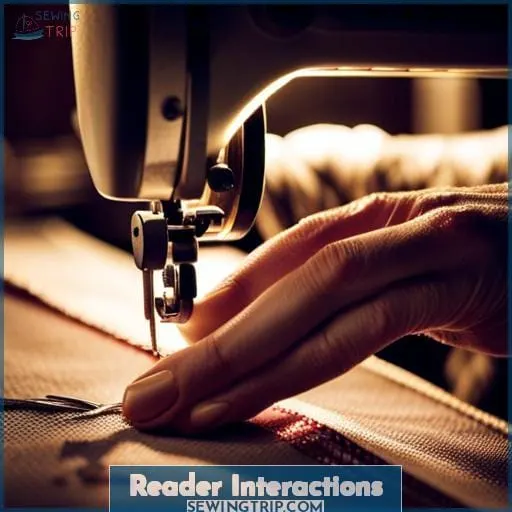This site is supported by our readers. We may earn a commission, at no cost to you, if you purchase through links.
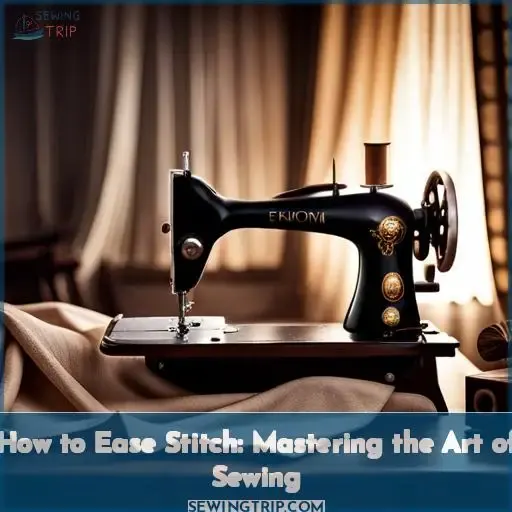 Picture yourself effortlessly gliding through the art of sewing, mastering every stitch with ease. In this guide, we’ll show you how to become a true sewing virtuoso by unraveling the mystery behind easing stitches.
Picture yourself effortlessly gliding through the art of sewing, mastering every stitch with ease. In this guide, we’ll show you how to become a true sewing virtuoso by unraveling the mystery behind easing stitches.
Say goodbye to frustrating puckers and hello to perfectly fitted garments. Whether you’re an aspiring seamstress or a seasoned pro looking for new techniques, this article will empower you with the skills needed to create flawless creations.
Table Of Contents
Key Takeaways
- Importance of fabric manipulation in ease stitching
- Role of stitch length in achieving flexibility and secure stitches
- Precision in pinning ensures a clean finish without irregularities
- Mastery in managing ease leads to confidence in stitch control
Understanding Ease Stitch
To understand ease stitch, gain insights into fabric characteristics through practical sewing experiences.
Fabric manipulation plays a crucial role in achieving successful ease stitching. Understanding how different fabrics behave allows you to select the appropriate tools and techniques for optimal results.
When it comes to ease stitching, stitch length is an important factor to consider. Choosing the right stitch length ensures that your stitches hold securely while allowing for flexibility and movement in the fabric.
Identifying reference points on your garment helps guide you during the pinning process. These points serve as markers for where you need to gather or distribute fabric evenly.
Pinning techniques play a significant role in easing sleeves or other areas of excess fabric into place seamlessly. Using proper pinning techniques ensures that there are no unsightly tucks or gathers along the seam line.
Tool selection is another critical aspect when it comes to understanding ease stitching. From long-handled tweezers for precise fabric manipulation to rulers for accurate measurements, having a variety of tools at your disposal enhances your ability to achieve professional-looking results.
In conclusion, understanding ease stitch involves recognizing key aspects such as fabric manipulation, selecting appropriate tool options based on project requirements and personal preferences., considering various factors like reference points ,stitch lengths ensuring smooth transitions between eased areas avoiding any puckering by using correct Pinning Techniques.
Preparation for Ease Stitch
Before beginning the ease stitching process, it’s essential to prepare the fabric and sewing machine setup for optimal results.
- Aligning edges: Squash the longer fabric edge together with the shorter one, ensuring they match up perfectly.
- Marking points: Use reference points at both ends of the area you’ll be easing to guide your stitching accurately.
- Sewing machine setup: Set your sewing machine to a long stitch length, which will make it easier for you to manipulate and gather fabric later on.
- Executing the stitch: Sew a straight line between your marked reference points using this long stitch setting on your machine.
By following these preparation steps, you’ll set yourself up for success in creating beautiful ease stitches that will enhance sleeve cap ease or any other gathering of fabric along an underarm seam.
Easing and Pinning Process
Gathering the fabric is an essential step in the easing and pinning process.
Once you have prepared your fabric for ease stitching, it’s time to gather the excess fabric and secure it in place.
To gather the fabric, hold it firmly and gently pull on the bottom thread to create gathers.
Adjust and tug from each side until the gathered area matches your desired width.
Pinning is another crucial aspect of this process, ensuring that you maintain accuracy and precision while sewing.
Use pinning techniques to evenly space out your pins along with avoiding clusters or ridges that may affect how smoothly your seam sews together later on.
By mastering these aspects of ease management, including gathering, pinning precision becomes second nature as you gain more confidence in controlling stitch length for a flawless finish every time.
Pro Tips for Ease Stitch
Now let’s dive into some pro tips that will help you master the art of ease stitching.
- Tool Mastery:
- Familiarize yourself with tools like long-handled tweezers or a ruler for precise fabric manipulation.
- These tools can make easing and pinning easier and more efficient, allowing for seamless sewing.
- Precision Pinning:
- Take your time when pinning the eased sleeve into the armscye, ensuring flatness along the seam line.
- This attention to detail will result in a clean finish without any tucks or gathers.
- Expert Patience:
- Easing requires patience and practice to control fabric bunching effectively.
- Acknowledge that fabric may bunch up during this process but emphasize how practice leads to mastery and independence from relying on specific tools over time.
4.Creative Alternatives:
- Sometimes traditional easing techniques may not be suitable for certain fabrics or situations, such as heavier materials where gathering is challenging.
- Explore alternative methods like using longer stitches carefully if necessary but exercise caution as this approach can lead to unintended tucks.
Remember these pro tips while mastering ease stitching techniques; tool mastery, precision pinning, expert patience,and creative alternatives are key elements in achieving fullness and ease in your sewing projects
Finishing and Alternatives
To complete the ease stitching process, you’ll need to focus on finishing touches and consider alternative methods for achieving a polished result.
- Pressing the Seam:
After sewing the eased sleeve into the armhole, give it a thorough press. This step helps identify any puckers or tugs that may require further adjustment.
- Checking Seam Appearance:
Take a close look at the seam once pressed. Aim for a smooth appearance with no visible puckers or gathers.
- Removing Ease Stitch:
Once you’re satisfied with how your eased sleeve looks, remove the ease stitch by giving it a firm tug on either end of your fabric.
These alternatives provide different approaches to achieve similar results in easing sleeves into armholes. Experimentation and practice will help you find your preferred method for achieving beautifully finished garments every time.
Reader Interactions
Have any questions or tips to share about the ease stitching process? We love hearing from our readers and creating a community of sewing enthusiasts.
Whether you’re a beginner looking for stitch troubleshooting advice or an advanced sewist eager to showcase your creative techniques, we welcome all forms of reader interactions.
Share your DIY projects, ask for help in our reader Q&A section, or simply engage with fellow sewing enthusiasts in the comments.
Our aim is to provide comprehensive sewing tutorials and empower you on your journey towards mastery.
Frequently Asked Questions (FAQs)
How do you determine the amount of ease needed in a garment?
To determine the amount of ease needed in a garment, measure your body and compare it to finished size measurements or pattern pieces minus seam allowance.
What are some alternative methods to ease stitching?
When it comes to easing in sewing, there are alternative methods you can explore.
Consider using gathering stitches.
Or even utilizing specialized tools for fabric manipulation.
Embrace the freedom to experiment and find your preferred approach!
Can ease stitching be used in other areas of garment construction besides sleeves?
Yes, ease stitching can be used in other areas of garment construction.
It’s commonly applied to bodices, waistbands, and skirts to ensure a smooth fit and comfortable movement throughout the entire garment.
How can you fix tucks or gathers that occur during the easing and pinning process?
Oh, the horror of tucks and gathers! Fear not, my sewing friend. To fix these pesky issues during easing and pinning, simply adjust your fabric as you sew, smoothing it out for a flawless finish.
Are there any specific fabrics that require different techniques for easing?
Certain fabrics, like heavyweight materials or those with minimal stretch, may require different techniques for easing. Experiment with longer stitches or alternative gathering methods to achieve smooth results and maintain your sewing mastery.
Conclusion
To truly master the art of sewing, it’s essential to understand how to ease stitches. By unraveling the mystery behind easing, you can say goodbye to frustrating puckers and hello to perfectly fitted garments.
With the right preparation and a careful pinning process, you can achieve flawless results in your sewing projects.
Remember to follow the pro tips for ease stitching and explore finishing techniques or alternatives to create the perfect finished product.
So grab your needle and thread, and unlock your sewing mastery with ease stitching.

